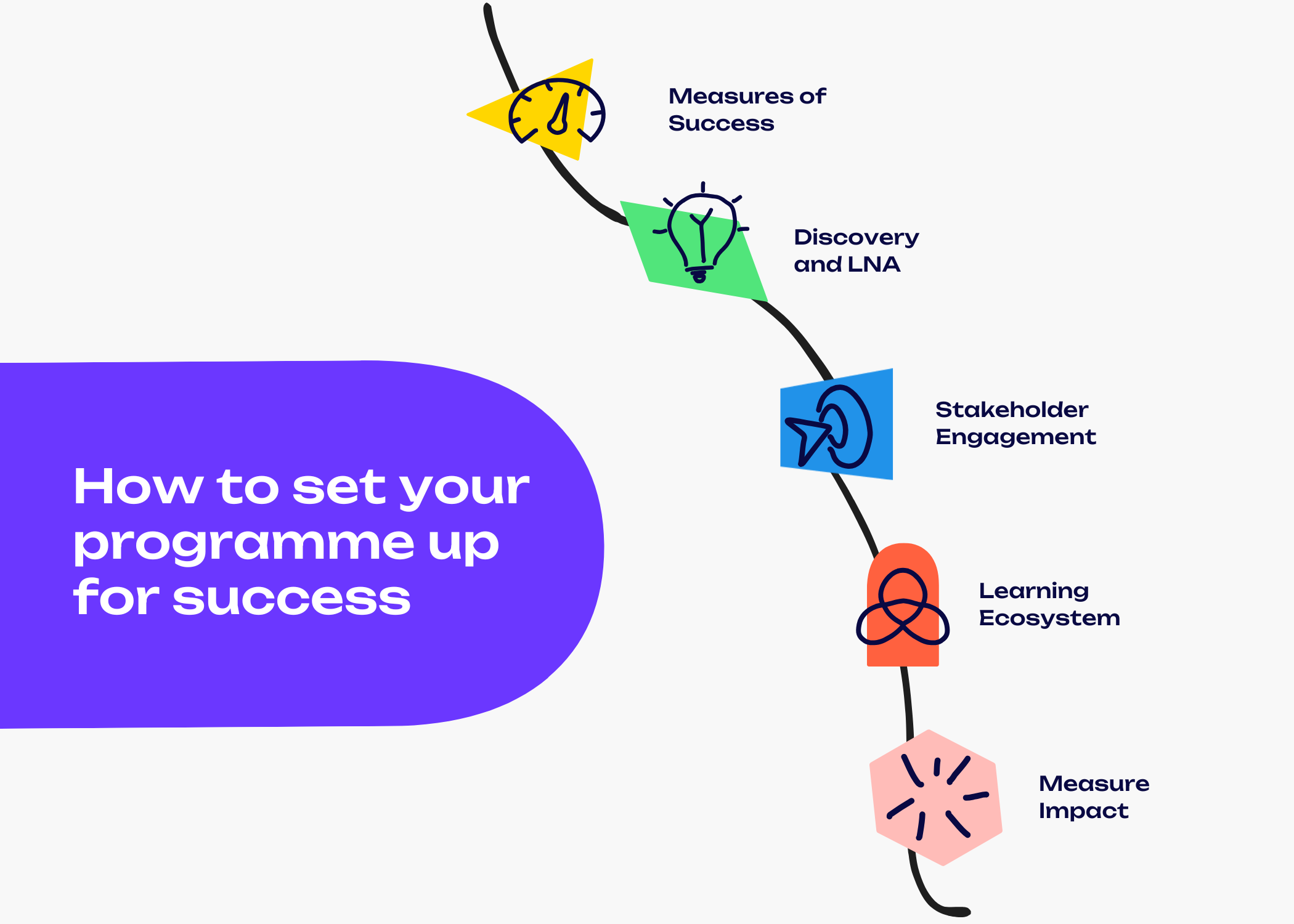

The Blog


Launching a leadership programme is exciting. It’s an opportunity to make a real difference, as you see behaviours shift and have a ripple effect across the organisation. It’s also one of the biggest investments you’ll make when it comes to developing people internally, so it’s important to get right.
As tempting as it is to dive into content design (or maybe that’s just us?), there’s a few ducks you need to get in a row first.
We see it all the time: companies racing ahead with good intentions, only to realise a few months later that the content doesn’t quite land, the engagement isn’t there and demonstrating the programme’s impact can feel a little tricky.
Here’s (almost) everything you need to know to set your programme up for success.
Beyond having “better leaders”, what are you hoping will be different at the end of the programme? Is it about improving leadership capability? Retaining talent? Succession planning? Whatever the goal, it’s important to be explicit from day one so you can demonstrate the impact later.
We’re preaching to the choir when we say we want your measures of success to be tangible, measurable and connected to your business strategy.
The key is not to define your measures of success in isolation. You want buy-in from your stakeholders, including your exec sponsors, so there’s a shared ownership of success. Trust us, this’ll help you later when those same stakeholders (unintentionally) become a blocker!
Here’s a couple of coaching-style questions you need to be asking:
Now you’ve defined success, it’s time to figure out where the barriers are. A proper Learning Needs Analysis (LNA) is an opportunity to really get under the skin of your organisation. You’re looking for insights as well as data.
If you’ve not done an LNA before, a good place to start is by exploring three key questions:
Some of the data will likely already exist, and others you might need to do a bit of digging. You want both qualitative and quantitative insights from:
Your sponsors and key stakeholders are everything when it comes to the success of a leadership programme. As well as being your biggest advocate, they’re also expecting you to deliver… whilst they (unintentionally) put barriers in your way… like not helping leaders prioritise time for the sessions, not helping them to embed the learning and our favourite, role modelling all the wrong behaviours (whoops, did we say that out loud?!).
Once you’ve completed your LNA, bring your key stakeholders together to share your findings and co-create clarity around what great leadership looks like for your business. Use this data to re-define and sign off your measures of success.
Here’s a couple of good coaching-style questions to ask:
This alignment does two things: it builds ownership at the top and ensures that the programme is seen as a company-wide investment, not an L&D initiative.
We often use the analogy that, as facilitators, we give people the resources to build a fire, we show them how to light it, but keeping the fire burning beyond the programme is their responsibility.
If you want your programme to drive lasting change, it needs to live inside an ecosystem. And we look at this through two lenses:
Your organisational culture and the systems that support leaders to embed their learning e.g. time to prioritise sessions, their own managers supporting their growth, as well as psychological safety to test out new behaviours and ways of working etc
The ecosystem you build into the programme design: touchpoints before, during and after the core learning experience e.g. prework, live sessions, peer coaching, toolkits, comms and nudges. Anything that makes it easy for leaders to keep new habits front of mind.
No, this isn’t the same as point 01, but linked to it. It’s really hard to prove impact if you don’t know what to measure and whilst people tell you “it was great!” is lovely to hear, it doesn’t demonstrate the actual impact the programme has had.
Feedback forms are super helpful for gauging how a session has landed and for making immediate iterations between sessions. But, they don’t measure how leaders have shifted their behaviour or changed how they lead.
Our little magic trick here is to go back to the outcomes you defined at the start. If you said your goal was to build more confident, coaching-led leaders, then measure for that. E.g. What indicators would show that confidence has grown? What would teams notice if leaders started coaching more effectively?
And don’t forget to involve your stakeholders in defining what “impact” looks like so that they’re both supportive and you can play back the risks of any pivots or fires that come your way that they ask you to work around.
Finally, keep measuring after the programme ends. A 6 month check in allows enough time to see behaviours being adopted and embedded into their every day.
There you have it. Five tips to making sure your next leadership programme is a cracking success. Remember: before you dive into design, take a breath. Ask the hard questions. And enjoy being able to deliver on one of the biggest challenges many L&D folk have: demonstrating measurable ROI.

Copyright Coachable Partners Limited. 128 City Road, London, EC1V 2NX